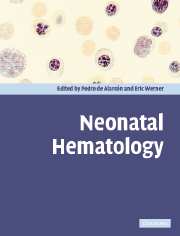Book contents
- Frontmatter
- Contents
- List of contributors
- Foreword
- Preface
- 1 Neonatal hematology: a historical overview
- 2 Disorders of the fetomaternal unit
- 3 Erythropoiesis, red cells, and the approach to anemia
- 4 Anemia of prematurity and indications for erythropoietin therapy
- 5 Hypoplastic anemia
- 6 Hemolytic disease of the fetus and newborn
- 7 Neonatal hemolysis
- 8 Neonatal screening for hemoglobinopathies
- 9 Polycythemia and hyperviscosity in the newborn
- 10 Newborn platelet disorders
- 11 Neutrophil function and disorders of neutrophils in the newborn
- 12 Immunodeficiency diseases of the neonate
- 13 Hemostatic abnormalities
- 14 Transfusion practices
- 15 Umbilical-cord stem-cell transplantation
- 16 Neonatal oncology
- 17 Normal values and laboratory methods
- Index
- References
15 - Umbilical-cord stem-cell transplantation
Published online by Cambridge University Press: 10 August 2009
- Frontmatter
- Contents
- List of contributors
- Foreword
- Preface
- 1 Neonatal hematology: a historical overview
- 2 Disorders of the fetomaternal unit
- 3 Erythropoiesis, red cells, and the approach to anemia
- 4 Anemia of prematurity and indications for erythropoietin therapy
- 5 Hypoplastic anemia
- 6 Hemolytic disease of the fetus and newborn
- 7 Neonatal hemolysis
- 8 Neonatal screening for hemoglobinopathies
- 9 Polycythemia and hyperviscosity in the newborn
- 10 Newborn platelet disorders
- 11 Neutrophil function and disorders of neutrophils in the newborn
- 12 Immunodeficiency diseases of the neonate
- 13 Hemostatic abnormalities
- 14 Transfusion practices
- 15 Umbilical-cord stem-cell transplantation
- 16 Neonatal oncology
- 17 Normal values and laboratory methods
- Index
- References
Summary
Overview
Over the past two decades, hematopoietic stem-cell transplantation has emerged as an effective approach to curative therapy for both pediatric and adult patients with aggressive or recurrent malignancies, congenital immunodeficiency diseases, some genetic diseases, including inborn errors of metabolism and hemoglobinopathies, and congenital and acquired bone-marrow-failure syndromes. Traditionally, autologous or allogeneic stem and progenitor cells have been obtained from bone marrow or mobilized peripheral blood. More recently, banked umbilical-cord blood (UCB) has emerged as an alternative source of stem and progenitor cells for transplantation. Cord blood is readily available and can be transplanted across partially mismatched human leukocyte antigen (HLA) barriers, increasing the availability of allogeneic stem-cell donors for patients lacking traditional HLA-matched related and unrelated donors. Additional applications of stem-cell therapies envisioned in the next decade, including regenerative therapies for nonhematopoietic tissues damaged by injury or disease, are currently unproven and the subject of ongoing preclinical research.
A major limitation to stem-cell transplantation therapy is donor availability. Only 20–25% of patients in need of a transplant will have an HLA-matched relative who can serve as their donor. Of those lacking a related donor, approximately 25% of Caucasian patients will identify an HLA-matched unrelated living bone-marrow donor through the National Marrow Donor Program and other donor registries, but less than 10% of patients of ethnic minority backgrounds will find a suitably matched unrelated marrow donor. For the remaining patients, a fully matched unrelated stem-cell donor cannot be identified.
- Type
- Chapter
- Information
- Neonatal Hematology , pp. 376 - 384Publisher: Cambridge University PressPrint publication year: 2005



